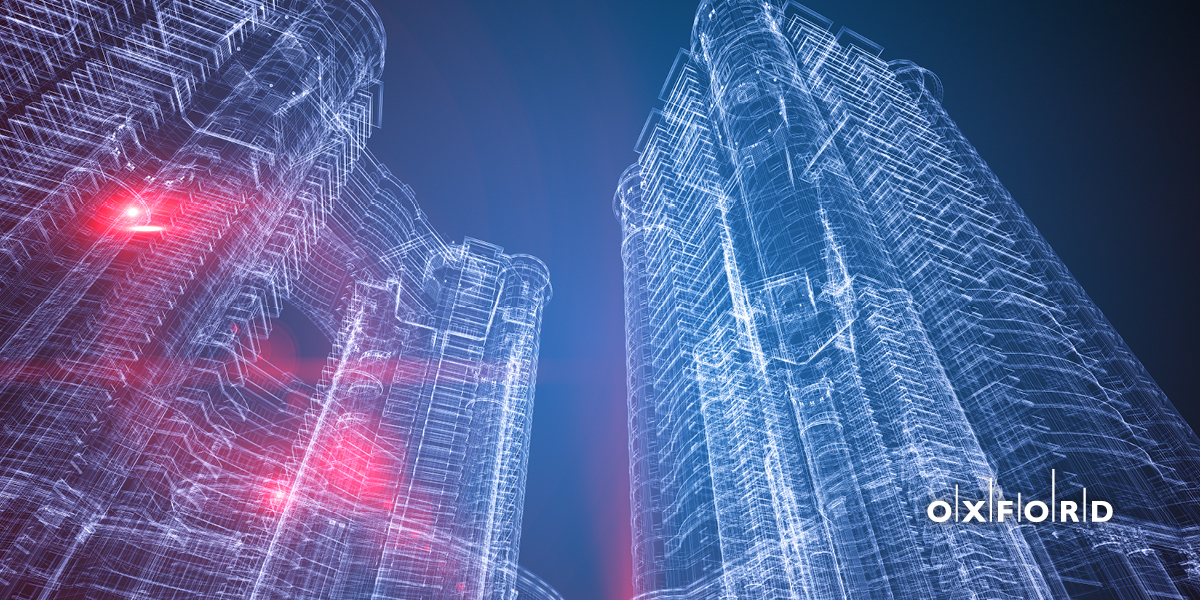Digital Twins: A Misunderstood Catalyst for Digital Transformation in Real Estate

By now you have probably heard about digital twins and likely think about them as a way to visualize a building using software, a version of CAD on steroids. You aren’t alone, as early vendors in the digital twin space have played up that aspect of this powerful capability in order to bring it to life.
However, visualization only scratches the surface of what digital twins bring to our industry and misses the point about the true nature of a digital twin. Digital twins are much more about what is “under the hood,” namely the accurate digital representation of how a building operates, connecting all the data across multiple systems into a living model of the mechanics of a physical building. When understood more completely it is clear that buildings with a fully conceived digital twin will be worth more than those without. And, when combined with other elements like simulation engines, machine learning and robotic process automation, digital twins create an innovation surface for buildings that promises to help us re-imagine how real estate services are delivered.
Let’s start at the beginning, though, with a definition. A digital twin is an exact digital replica of a physical object or system that allows us to better understand and optimize its performance and design. The concept of digital twins dates to 1991, but it took until 2002 for Dr. Michael Grieves to apply the concept to complex product engineering (jet engines, turbines etc.). His work was motivated by the fact that complex products are difficult, expensive and time consuming to design, manufacture and operate. By creating a “digital twin” rather than a physical prototype the whole process of designing, testing and refining a product could be accelerated and made much less expensive using powerful software.
It took until relatively recently for digital twins to make their way to commercial real estate, and even then, the most significant use case was as part of the construction process. This was a natural evolution of the advanced BIM modelling that was already mature in the construction industry. By combining the spatial models from BIM with static and live sensor data from the buildings, an operational twin emerged for newly constructed buildings.
While this was an important step forward, the narrow application of digital twins to new construction has constrained their true value to commercial real estate and missed the point that buildings with a digital twin are inherently more valuable than those without. New construction accounts for a small proportion of the overall stock of buildings in the world. Imagine, instead, if every building had a live model representing the up-to-date status of the building and all of its services, available from anywhere. Such a capability would have an impact across our entire value chain increasing the value of an asset directly.
In this way, digital twins are a key part of re-imagining how existing buildings operate. Buildings are complex systems that consist of a myriad of different elements, each often operating independently. Elevators, lighting and electrical systems, HVAC, security, access control and other systems operate in silos, forcing operations teams and service providers to monitor and manage each of them separately. As a result, we lack a true picture of the full building, one that our operations teams and service providers can more effectively optimize for energy, carbon, cost, janitorial, security, customer experience, etc.
Making things even more complex, each building is so different that it is challenging to understand and manage performance across buildings in a portfolio or explore how they form part of an interconnected digital campus or Smart City. Compounding this complexity is a lack of an industry standard ontology to normalize data. This is where digital twins add a new layer of value by enabling us to look across assets in a consistent way and allowing buildings to more effectively integrate into their digital environment.
Beyond operational value, asset managers can leverage digital twins to more accurately target capital investments, lower insurance costs, and better manage risk by more clearly understanding their assets and providing accurate and transparent data to underwriters, lenders, co-investors, potential acquirors and other providers. In addition, buildings with twins will be that much easier to acquire or divest, lowering the risk during due diligence with increased transparency, while streamlining onboarding into a portfolio. And, buildings with digital twins will be much more effective at optimizing for sustainability with a clearer total picture of energy, water consumption and waste.
By thinking more broadly about how we can embrace digital twins, combining them with other powerful tools, and integrating them into our decision processes, we can create a unique and powerful innovation surface that will result in more valuable assets driving better customer experiences. We are already seeing this in industries that were earlier to adopt digital twins.
Innovative companies in energy, power and utilities are working with companies like Norway’s Cognite to combine industrial digital twins with advanced analytics and machine learning to realize 20-30% reductions in maintenance costs, > 30% improvements in worker productivity, and 10-20% reductions in carbon emissions. General Electric has been a pioneer at using digital twins and has taken the next step by combining their digital twins with generative/ algorithmic design capabilities to significantly accelerate their design processes. Singapore has announced the construction of a digital twin of their complete shipping and logistics ecosystem. Alphabet’s Sidewalk Labs has launched the Delve software platform to use generative design to rapidly iterate master plans given a specific building site. By combining digital twins with powerful simulation engines, we can explore what-if scenarios such as planning maintenance and deploying capital more efficiently.
Microsoft has emerged as a key enabler for digital twin solutions in commercial real estate and other industries. With its Microsoft Azure Digital Twins platform, developers can design and create digital replicas of the physical environment, integrated with a live execution environment and complementary capabilities including indoor maps, simulation, and others. Furthermore, the RealEstateCore ontology, released as open source models using Microsoft’s Digital Twins Definition Language, provides the shared language which disparate applications, assets, and devices can use to integrate with each other.
It is admittedly, very early days for digital twins in commercial real estate. There are many technical, logistical and financial hurdles to overcome to make digital twin technology practical and affordable. However, the promise of autonomous buildings optimized by a digital twin that can be operated from anywhere while delivering enhanced experiences to customers, and the economics advantages that result, are just too significant to pass up. We cannot yet imagine the innovation that such digital twin powered buildings, and portfolios, will unleash, but we can be certain that assets powered by a digital twin will be inherently worth more.
This Week’s Sponsor
Yardi® develops and supports industry-leading investment and property management software for all types and sizes of real estate companies. Established in 1984, Yardi is based in Santa Barbara, Calif., and serves clients worldwide. For more information on how Yardi is Energized for Tomorrow, visit yardi.com.
Read Next
 5/15/2025
5/15/2025
Tech, Talent and Transformation: 2025 Digie Finalists Announced For 27 years, Realcomm has presented the Digie Awards to acknowledge companies, real estate projects, technologies, and individuals that have advanced the commercial real estate industry through the strategic use of technology, automation, and innovation.
 5/15/2025
5/15/2025
Empowering Space Management with Data-Driven Visualization For effective CRE space management, it’s critical to centralize lease data, maximize rental square footage (RSF), improve energy efficiency and reconfigure spaces to meet changing needs.
 5/8/2025
5/8/2025
The AI-Powered Workplace Evolution: Redefining the Business Landscape In today's rapidly evolving business environment, the fusion of Artificial Intelligence (AI) and Workplace Management is revolutionizing the way organizations approach workspace optimization and operational efficiency.
 3/27/2025
3/27/2025
The Convergence of Edge Computing, Cloud, and AI in Building Automation and Smart Buildings In the built environment, we have seen the convergence of Operational Technology (OT) and Information Technology (IT), later expanding to include Workplace Technologies (WP).








%20(1)%20(1)%20(1).png)




.png)